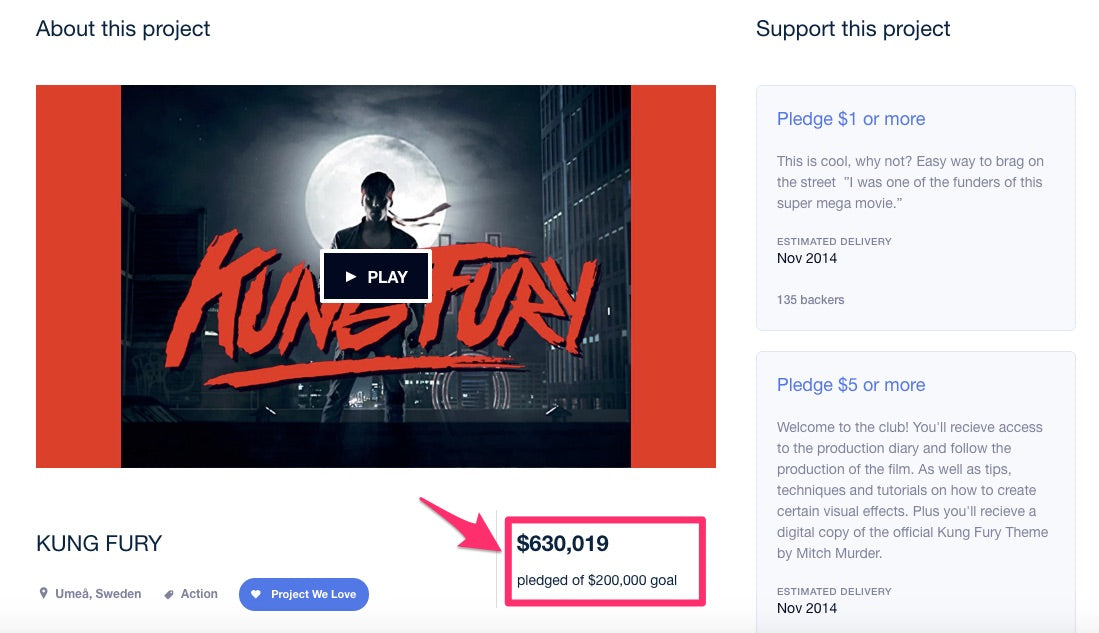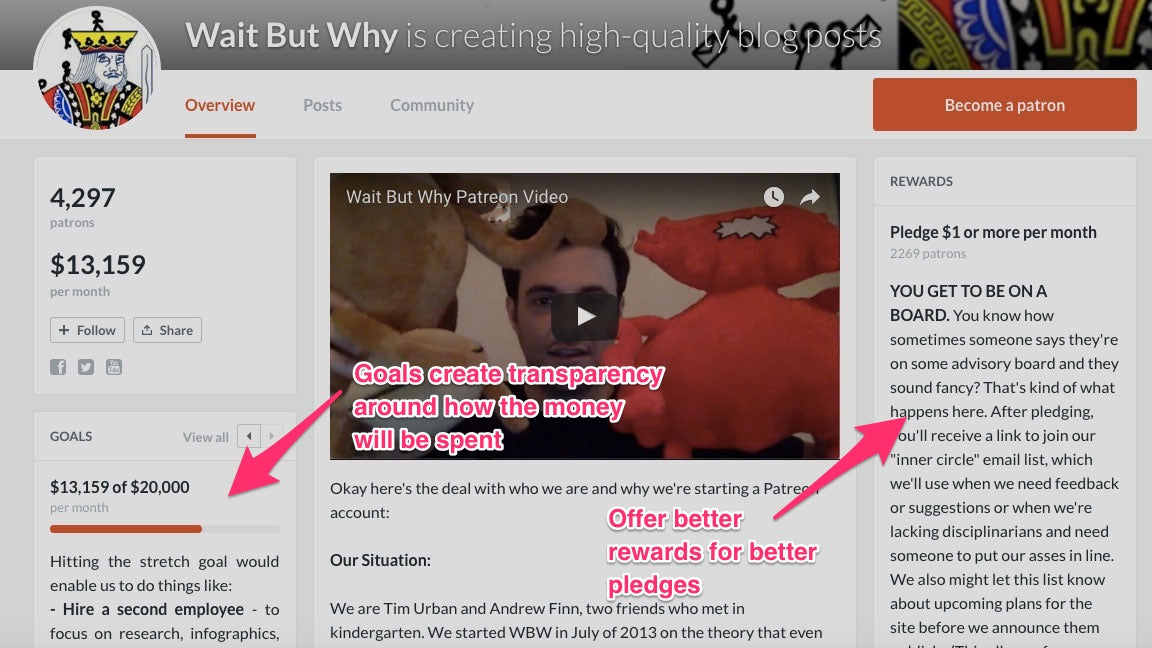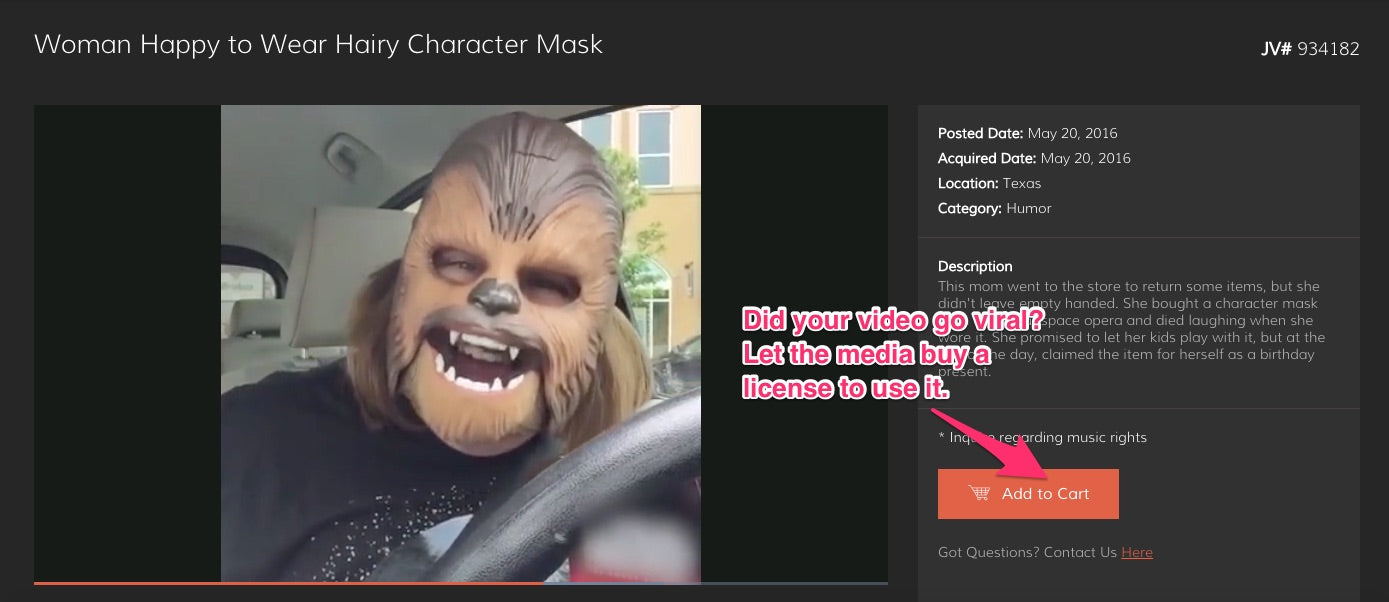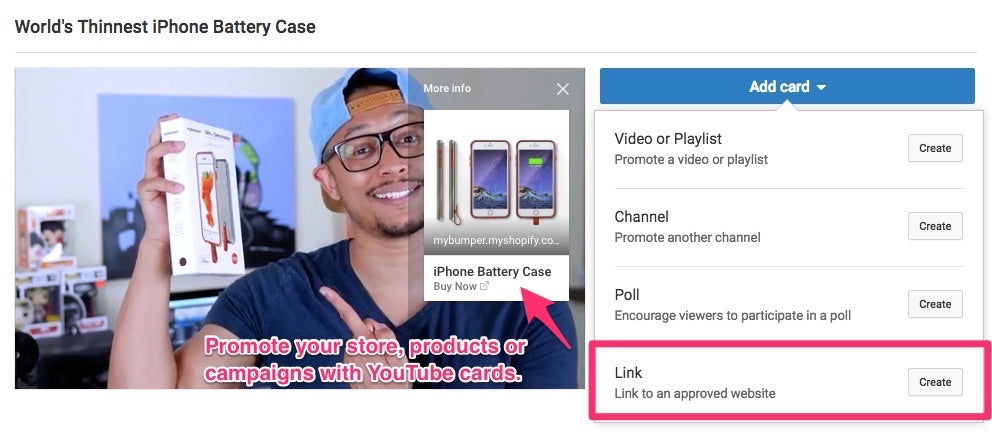
YouTubers are the self-made celebrities of today: People who have earned an audience by creating content geared toward teaching, entertaining, reviewing, and being awesome on the internet.
And most do it just to do it—to scratch the itch of creating things and being in front of an audience.
Making money from a YouTube channel probably isn’t the reason you’ll start one, but the opportunities to earn are a pleasant surprise once you realize how many of them there are.
In fact, New Media Rockstars estimates that top YouTubers earn in the millions, some even in the tens of millions.
Here are just some of their estimates:
- EpicMealTime makes around $3.1 Million (7 million subscribers)
- Ray William Johnson sits at $4.2 Million (10 million subscribers)
- FunToyzCollector weighs in at a whopping $30.4 million (8 million subscribers)
However, YouTube channels on the smaller side can still be monetized. Your earning potential isn't determined solely by the number of subscribers and views you have, but also by the level of engagement you generate and the niche you cater to.
That said, before we talk about how to make money on YouTube, you’ll need to have a clear understanding of what your audience looks like first.
Selling merch is easier than you think!
Learn how to build your own store and sell t-shirts, mugs, and other merchandise in The Ultimate Guide to Setting up a T-Shirt Store.
GET THE FREE GUIDEUnderstanding Your Audience Demographics
Building your own audience puts you in a great position to monetize in a variety of ways. But you’ll only be able to take full advantage of the opportunities you have if you understand the makeup of your audience.
For many YouTubers looking to monetize, the more niche your channel is, the better a position you’ll be in to work with brands looking to target specific audiences (more on that later).
Take a look at your audience's demographic information by clicking here.

You'll want to pay especially close attention to:
- Gender for the distribution of male and female, and if your audience skews one way.
- Age for the ranges that most of your audience members fall into.
- Geographic location for the countries or cities where your viewers are watching your videos and some brands might want to focus on.
- Watch Time: The overall engagement of your audience wihen watching your videos.
- A combinations of the above to paint a more accurate picture of your audience by looking at things like the number of male viewers you have in a specific age range.
With this demographic information at hand, you'll have a better understanding of your own audience and also be able to work better with brands. For more on interpreting your YouTube analytics, check out this post.
Now, we can start talking about the different ways you can actually make money.
Making Money on Youtube
There are several ways to make money on Youtube.
- Become a YouTube Partner and Make Money From Ads
- Make Money On YouTube By Selling Products or Merchandise
- Crowdfund Your Next Creative Project
- Let Your Audience Support Your Work Through Fan Funding
- License Your Content to the Media
- Work With Brands as an Influencer
Let's take a deeper look at each one.
1. Become a YouTube Partner and Make Money From Ads
The first revenue stream you’ll likely explore is ads.
You'll need to set yourself up as a YouTube Partner, which is easily done in the Creator Studio section of your YouTube account by going to the Channel menu to verify your account and enable Monetization (click here to go there directly).
After you become a Partner, you'll need to have an AdSense account to opt into Google's advertising network to actually get paid and see ad revenue reports like the one below. If you don't have one, you can apply for one here.

Once that's done, you'll notice a green "$" next to your videos in the Video Manager, indicating whether it's been enabled for monetization, which you can click on to access the monetization settings for each video.
It's easy to set up, but advertising as a YouTube partner is far from being the most lucrative revenue stream you can create for yourself.
Why You Should Look Beyond Ads for Revenue
YouTube recently received a lot of backlash due to its decision to be more transparent about advertising on the platform and what qualifies as “advertiser-friendly” content. Essentially, many creators feared they would lose out on the ad revenue that helps support their channel due to the nature of their content.
According to YouTube, your content could get excluded from ads if it includes:
- Sexually suggestive content, including partial nudity and sexual humor
- Violence, including display of serious injury and events related to violent extremism
- Inappropriate language, including harassment, profanity and vulgar language
- Promotion of drugs and regulated substances, including selling, use and abuse of such items
- Controversial or sensitive subjects and events, including subjects related to war, political conflicts, natural disasters and tragedies, even if graphic imagery is not shown.
But the reality is that YouTube has been demonetizing content that it doesn't deem “advertiser-friendly” since 2012 via an automated process.
YouTubers were already losing out on ad revenue because their videos would at times be demonetized without warning and without their knowledge.
Now the situation is actually better, as creators are notified when this happens and can contest any videos that were mistakenly excluded from YouTube's advertising network.
Advertising might be a common means of generating passive income for creators, but the trade-off is that YouTube gets to keep around 45% share of ad revenue.
In short, YouTubers should explore other revenue streams to sustain their creative hobby.
So let’s do that.
2. Make Money On YouTube By Selling Products or Merchandise
Selling merchandise—t-shirts, coffee mugs, tote bags, snapbacks, you name it—has a benefit beyond revenue.
It increases your exposure by putting your online brand and personality out there into the offline world, and deepens the relationship between you and your fans as they literally “buy into” what you're doing.
 Roman Atwood sells a variety of merchandise in his own store under his Smile More brand.
Roman Atwood sells a variety of merchandise in his own store under his Smile More brand.
Selling branded swag is easier than it might seem at first.
You can order affordable designs tailored for specific products, like t-shirts, using freelance sites such as Fiverr.
And when it comes to handling orders and customers, you can integrate your store with services such as Printful or one of the many print-on-demand providers that take care of all the shipping, fulfillment and customer support, letting you reap all of the benefits of a dropshipping business that demands less effort on your part. Plus, you don't need to worry about any printing costs until you actually make sales.
Set Up Your Own Store on Shopify Today!
Start your free 14-day trial—no credit card required.
Alternatively, you can partner with an existing merchandising network for creators such as DFTBA(Don’t Forget to Be Awesome). However, you'll be competing with other YouTubers in a marketplace and have less control over adding products, offering discounts, integrating your content, and all the advantages that come with owning your own ecommerce site.
You can even go a step further by manufacturing and selling your own unique products, powering your business with your YouTube channel like Luxy Hair did to sell their hair extensions with hair-related how-to video tutorials.
As a YouTuber who’s already earned an audience, you’ll have two advantages from the start that other store owners would be jealous of:
- A content engine that consistently drives traffic to your store.
- Your audience's trust, which you've already earned by regularly serving them your own brand of content for free.
3. Crowdfund Your Next Creative Project
When money is all that stands between an idea and its execution, crowdfunding is a good way to make it happen.
Whether you need help buying better equipment, hiring actors or covering other production costs, you can call upon your own audience and the crowdfunding community to pitch in if your idea is compelling enough.
Many successful crowdfunded creative projects tend to offer a sneak peak or “trailer” that gets people excited, so consider shooting a video explaining your project or offering a taste of what it'll be like, such as this popular Kickstarter for Kung Fury, a short film paying homage to the 80s action movie.

Popular crowdfunding sites with a proven track record of campaigns from YouTubers include:
- Kickstarter: One of the most well-known crowdfunding sites and great for funding cool products and creative projects. Be sure to set an attainable funding goal because you'll only secure it if you actually meet the goal you set.
- Indiegogo: A Kickstarter alternative that offers more flexible funding options.
4. Let Your Audience Support Your Work Through Fan Funding
Similar to crowdfunding a project, you can also set up “fan funding” streams to source donations from your audience.
As a creator, you're contributing your voice to the internet without forcing your audience to pay for admission. So, if it’s good content, your audience might be inclined to support you on an ongoing basis.
Many fan funding platforms offer creators another place for people to discover their content and a way to engage their most loyal audience and reward them for their support.

Some popular fan funding options include:
- YouTube's Fan Funding: This feature on YouTube essentially lets you create a “tipping jar” for your viewers to donate whenever and however much they feel like contributing. You'll need to set up your YouTube account for advertising as outlined above.
- Patreon: One of the smartest fanfunding solutions as it lets supporters offer recurring donations to help fund your work. Like Kickstarter, you can also incentivize donations with different tiers for pledges that unlock special rewards.
- Tipeee: Lets you get a combination of both one-off and recurring donations
5. License Your Content to the Media
If you happen to create a viral video with mass appeal—say, a funny clip featuring your dog—you can license your content in exchange for money.
TV news outlets, morning shows, online news sites, and other creators might reach out about the rights to use your videos if they happen to go viral.
However you can also list your videos in a marketplace such as Juken Media where your content will be easier for the right people to find and purchase.

6. Work With Brands as an Influencer
Influencer marketing is going to be one of the advertising bedrocks of the next decade.
Brands are investing more and more in influencer marketing, spending their typically large advertising budgets on influencers who’ve already won the loyalty of their audiences.
This creates a massive opportunity for you as a creator if you can negotiate the right deals.
Brendan Gahan, a YouTube marketing expert and influencer, recommends you establish your baseline flat fee by looking at the number of views your videos typically get and multiplying it by 5 to 15 cents per view (which is around what many brands are willing to pay for views via YouTube ads).
Depending on your leverage—your audience demographics, content quality and how unique and profitable your niche is—you might be able to negotiate a better deal if the brand is a good fit.
To give you another idea of what you can potentially charge, a mid-level influencer charges a brand on average $200 to $500 per post, according to one study.
The same study also shows that around 69% of YouTubers surveyed don’t think that partnering with brands detracts from their authenticity.
The key when partnering on brand sponsored content is to be transparent about it—not endorsing anything you don’t actually like or believe in, and being upfront with your audience about why you’re doing it.
Here are jus a handful of the many influencer marketplaces you can add your channel to and get discovered by brands both big and small:
- Grapevine Logic: One of the more popular influencer marketplaces, you only need 1000 followers to join.
- Famebit: With a wide range of brands to work with, you might find a sponsorship opportunity you'll be proud to be a part of. You need 5000 followers to join.
- Channel Pages: Partner with other YouTubers as well as brands.
- Crowdtap: Complete small content creation "tasks" in exchange for money and other rewards. There's no restriction on how many followers you need to join.
Some influencer marketplaces offer you free products, while others are known for having big brands who are willing to pay more. Capitalize on the opportunities that best suit your needs, but list yourself in as many places as you can to ensure maximum visibility for your channel.
For more on how to work sponsored content or product placement into your videos, check out YouTube's Guide to Paid Product Placement.
How to “Sell” Without Annoying Your Audience
Many of the above strategies for monetizing involve promoting products (e.g. your store) or campaigns (e.g. crowdfunding a video series). You’ll still need to make your audience aware of these without sabotaging the integrity of your content.
"Selling out" to their audience is a real concern for a lot of creators. But if you never ask, you’ll never get.
There’s a number of “placements” you can choose from for promoting products or your campaigns.
Record a Call to Action in Your Videos
"If you liked this video, then hit the like button and subscribe."
Many YouTubers include a call to action along those lines at the end of their videos to grow their viewership. By suggesting the intended action you want them to take, your audience is more likely to actually take it.
You can adapt this approach to direct your audience's attention to a revenue-generating opportunity.
Add Well-Timed YouTube Cards to Your Videos
Whether it's part of your deal with a brand or you're promoting your own products, YouTube Cards offer an eye-catching way to get the attention of engaged viewers.
You can set them to pop up at just the right moment when they're most relevant and least distracting to increase their impact.

Add Links to Your Video Descriptions
You can funnel viewers to your store, Patreon page, Kickstarter campaign, or other revenue-focused part of your online presence by adding links to your video descriptions.
Promote Your Offer on Other Platforms
Just because your content is hosted on YouTube, doesn't mean you shouldn't be taking advantage of all the other channels out there for distribution.
Spread the word about new campaigns or discounts on Twitter, Facebook and any other profiles you might own.
The more places your message lives, the greater the chance that it'll be seen. So it's always a good idea to grow your social media following beyond YouTube.
Rise of the "YouTubepreneur"
What compels most creators to create is rarely the money. It's the thought of making something for the world to enjoy.
But ironically, that puts them in a great position to actually make money in a content-obsessed world.
While the hard part for many businesses is getting and keeping their audience's attention, YouTubers have already figured that bit out.
All that's left is to get creative—to channel the entrepreneurial drive to explore ideas— with how you choose to monetize your passion.
Smm Panel
উত্তরমুছুনsmm panel
iş ilanları
instagram takipçi satın al
hirdavatciburada.com
https://www.beyazesyateknikservisi.com.tr/
servis
tiktok jeton hilesi
kartal mitsubishi klima servisi
উত্তরমুছুনtuzla vestel klima servisi
maltepe vestel klima servisi
kadıköy arçelik klima servisi
ümraniye samsung klima servisi
ümraniye mitsubishi klima servisi
beykoz vestel klima servisi
üsküdar vestel klima servisi
beykoz bosch klima servisi
minecraft premium
উত্তরমুছুনen son çıkan perde modelleri
uc satın al
özel ambulans
en son çıkan perde modelleri
yurtdışı kargo
nft nasıl alınır
lisans satın al